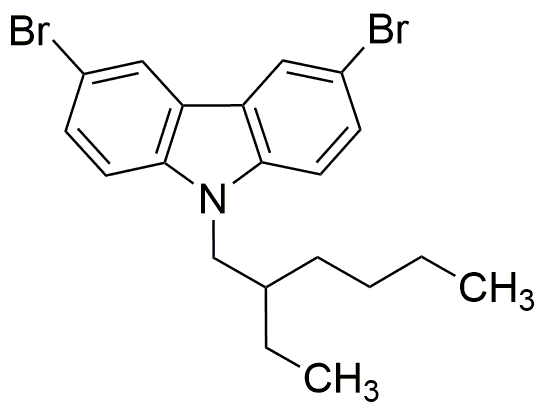3,6-Dibromo-9-(2-ethylhexyl)carbazole is widely utilized in research focused on:
- Organic Electronics: This compound is used in the development of organic light-emitting diodes (OLEDs), offering improved efficiency and color purity compared to traditional materials.
- Photovoltaic Cells: It serves as a key component in organic solar cells, enhancing light absorption and energy conversion efficiency, making solar technology more accessible and effective.
- Fluorescent Dyes: The compound is employed in creating fluorescent markers for biological imaging, providing high sensitivity and specificity for researchers in the life sciences.
- Polymer Additives: It acts as a flame retardant in polymers, increasing safety in materials used in construction and consumer products, thus addressing fire hazard concerns.
- Environmental Monitoring: This chemical is utilized in sensors for detecting pollutants, aiding industries in compliance with environmental regulations and promoting sustainability.
Información general
Propiedades
Seguridad y normativas
Aplicaciones
3,6-Dibromo-9-(2-ethylhexyl)carbazole is widely utilized in research focused on:
- Organic Electronics: This compound is used in the development of organic light-emitting diodes (OLEDs), offering improved efficiency and color purity compared to traditional materials.
- Photovoltaic Cells: It serves as a key component in organic solar cells, enhancing light absorption and energy conversion efficiency, making solar technology more accessible and effective.
- Fluorescent Dyes: The compound is employed in creating fluorescent markers for biological imaging, providing high sensitivity and specificity for researchers in the life sciences.
- Polymer Additives: It acts as a flame retardant in polymers, increasing safety in materials used in construction and consumer products, thus addressing fire hazard concerns.
- Environmental Monitoring: This chemical is utilized in sensors for detecting pollutants, aiding industries in compliance with environmental regulations and promoting sustainability.
Documentos
Hojas de datos de seguridad (HDS)
La SDS proporciona información de seguridad completa sobre la manipulación, el almacenamiento y la eliminación del producto.
Especificación del producto (PS)
La PS proporciona un desglose completo de las propiedades del producto, incluida la composición química, el estado físico, la pureza y los requisitos de almacenamiento. También detalla los rangos de calidad aceptables y las aplicaciones previstas del producto.
Certificados de análisis (COA)
Busque certificados de análisis (COA) ingresando el número de lote del producto. Los números de lote y de partida se pueden encontrar en la etiqueta de un producto después de las palabras "Lote" o "Lote".
Número de catálogo
Número de lote/lote
Certificados de origen (COO)
Este certificado de origen confirma el país en el que se fabricó el producto y también detalla los materiales y componentes utilizados en él y si se deriva de fuentes naturales, sintéticas u otras fuentes específicas. Este certificado puede ser necesario para cumplir con las normativas aduaneras, comerciales y regulatorias.
Número de catálogo
Número de lote/lote
Hojas de datos de seguridad (HDS)
La SDS proporciona información de seguridad completa sobre la manipulación, el almacenamiento y la eliminación del producto.
DownloadEspecificación del producto (PS)
La PS proporciona un desglose completo de las propiedades del producto, incluida la composición química, el estado físico, la pureza y los requisitos de almacenamiento. También detalla los rangos de calidad aceptables y las aplicaciones previstas del producto.
DownloadCertificados de análisis (COA)
Busque certificados de análisis (COA) ingresando el número de lote del producto. Los números de lote y de partida se pueden encontrar en la etiqueta de un producto después de las palabras "Lote" o "Lote".
Número de catálogo
Número de lote/lote
Certificados de origen (COO)
Este certificado de origen confirma el país en el que se fabricó el producto y también detalla los materiales y componentes utilizados en él y si se deriva de fuentes naturales, sintéticas u otras fuentes específicas. Este certificado puede ser necesario para cumplir con las normativas aduaneras, comerciales y regulatorias.


